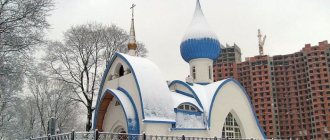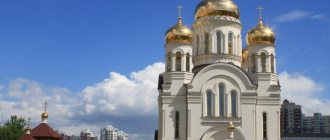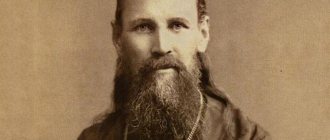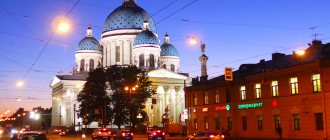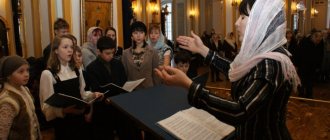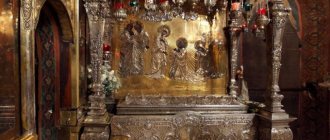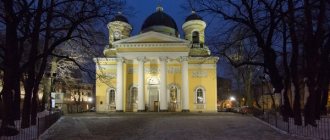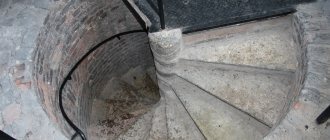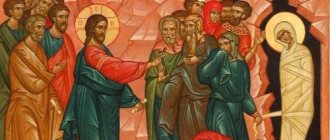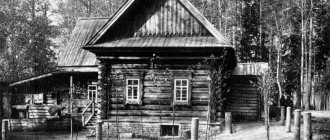Holy Righteous John of Kronstadt was an extraordinary personality for his era. In addition to possessing the gift of clairvoyance, he could heal from physical ailments. He did not stay away from charity. Father turned out to be the first priest in Russia who was allowed to conduct general confession.
About the author About the book
Even during his lifetime, thousands of pilgrims flocked to the confessor every year. He took care in advance of the place of his own burial, where the relics of Fr. John, the favorite of thousands of ordinary believers.
History of John of Kronstadt
John of Kronstadt is one of the most peaceful, bright saints in the history of the Russian Orthodox Church. He was certainly a very charismatic man, one of the greatest preachers of the word of God.
If you now read his sermons from sight, they will not make any strong impression. But contemporaries recalled that Father John of Kronstadt had such a message as a preacher that his every word struck the very heart of his listeners and evoked a very deep response.
Suffice it to say that this saint was characterized by the so-called general confessions, when a repentant sermon brought several thousand people into a state of deep sincere repentance.
Find out more about the amazing life story of this saint on our Yandex channel. Zen.
Temples
The spectacular architectural monastery is considered one of the most beautiful cathedrals and temples in St. Petersburg. The central place in it is occupied by the Temple of the Twelve Apostles - a large church in the neo-Byzantine style, built at the beginning of the last century from two-color brick.
Monastery Gate
The five-domed church with a belfry is located on the two upper floors of the monastery complex. After restoration in 1991, two chapels were consecrated in it. The beautiful facades are decorated with intricate brick patterns and large icons. The massive helmet-shaped domes and gilded crosses of the main monastery cathedral are visible from different parts of the Petrograd side and from the Karpovka valley.
On the ground floor of the building there is a single-altar church of St. John of Rila. Its walls and vaults are decorated with paintings of religious subjects and picturesque ornaments, and the floor is made of two-color stone tiles.
In the basement there is a tomb with the relics of Father John. Historically, this temple was consecrated in honor of the Prophet Elijah and Queen Theodora, the heavenly patrons of the parents of the righteous man. The body of the saint lies in a white marble sarcophagus, which is marked with a cross and large letters “I” and “K”.
Chapel of the Intercession of the Blessed Virgin Mary
Behind it you can see a single-tier carved wooden iconostasis. Icons and biography of the saint hang on the walls. The floor is covered with soft carpets that muffle the noise of voices and footsteps. Under the low arches there is a soft light and there are always a lot of flowers.
At the corner of the stone fence of the monastery there is a small but very elegant Intercession Chapel. A small wooden temple on a stone foundation was built in 1910 according to the design of N. N. Nikonov. In the 1920s, it was closed and converted into a transformer booth, and then completely demolished.
For the 100th anniversary of the monastery, in the 1999-2000s, the neo-Byzantine chapel was rebuilt according to a project prepared by the architect A.P. Viktorov. The single-domed church on a high plinth is in perfect harmony with the main building of the monastery and fits perfectly into a single architectural ensemble.
Temple-burial vault of Saint Righteous John of Kronstadt
Shrines of the monastery
Today, the relics of the saint are kept in the crypt - the underground part of the temple, where even during the construction of the monastery, Father John ordered to prepare a place for his resting place. This is the very place where the presence of the holy, spiritual concentration of the monastery is especially felt.
It is here that thousands and thousands of pilgrims come every day. The flow of believers here did not dry out even during the years of Soviet power. Everything that is happening today with the Ioannovsky Convent is another fulfilled prophecy of St. John of Kronstadt.
He said:
“This place will be enlightened, from unsettled it will be well-ordered, from little-known to much-known.”
History of the monastery
In 1900, merchant Simeon Ramensky donated a plot of land near the Karpovka River to Father John so that a new Orthodox monastery could appear in the capital of the Russian Empire. It was decided to dedicate the monastery to the Bulgarian Saint John of Rila, who lived in the 10th century.
A detailed design of the monastery buildings was prepared by the St. Petersburg architect Nikolai Nikitich Nikonov. After the approval of the architectural project by Emperor Nicholas II, Father John began construction. City officials and Bishop of Yamburg Boris (Plotnikov) took part in the ceremonial laying of the buildings.
At first, the new convent was considered a metochion of the Surskaya St. John the Theological Monastery. Thanks to the enormous authority of Father John and the love of the believers for him, help came from different directions. Donors contributed the required money, and contractors quickly resolved all issues that arose.
General view of the Ioannovsky Monastery
The construction of the monastery proceeded quickly. In 1901, the first church appeared in the lower floor of the main building, and the huge building was built in just 3 years. The new Orthodox monastery turned out to be so large that in 1902 it was given the status of a first-class monastery.
The magnificent Cathedral of the Twelve Apostles had two chapels. A high bell tower adjoined the building from the west, and five massive domes rose above the temple.
Even during the life of Father John, the monastery was quite prosperous and independently provided itself with everything necessary. Before the revolution, more than 350 nuns lived there. The monastery had icon-painting, seamstress and gold-embroidery workshops. There was a prosphora bakery and two ovens on site, where more than 1,000 prosphoras were baked at a time.
Church of the Twelve Apostles of St. John's Monastery
To the east of the monastery there is a vegetable garden, and to the west there is an orchard. The plots of land were small, but the sisters worked hard and produced a good harvest from their farm every year. When the First World War began, a small infirmary was opened in the monastery, where the nuns helped restore the health of soldiers wounded in battle.
In 1908, at the age of 80, Father John died. According to his will, the respected priest was buried in the tomb, which he built for himself in the crypt of the St. John’s Monastery. The white marble tomb of Father John immediately turned into a place of pilgrimage, and thousands of believers came here at any time of the year.
After the change of power, the state's attitude towards the church changed. In 1919, a labor commune was established in the monastery. Four years later, the monastery was liquidated, the nuns were sent into exile, and the buildings were distributed to various organizations. Some of the buildings went to the reclamation technical school.
Some churches were demolished as unnecessary. During the years of the state's struggle with religion, the beautiful tented chapel of St. John of Rila, which stood on the river bank, was lost. By decision of the Leningrad authorities, the house church of St. Nicholas the Wonderworker was demolished in one of the monastery refectories.
Despite the fact that the monastery no longer existed, believers continued to come to the crypt, where the relics of Father John lay. To deprive them of the opportunity to pray near the revered shrine, in 1926 the entrance to the basement was walled up with bricks. During the Great Patriotic War, the room was opened up and a bomb shelter was made inside the former crypt. Here, residents of Leningrad escaped during German air raids on the city.
The time of oblivion and destruction dragged on for more than 60 years, until the old monastery was finally returned to the diocese. In 1989, the monastery was a pitiful sight. There were more than 20 outside organizations on its territory. The interior structure of the premises was destroyed or altered, and the buildings were in need of repair.
Monastery domes
Despite the losses and desolation, so many city residents came to the first service that the temple could not accommodate everyone. The church service had to be broadcast to the street through speakers.
Initially, the monastery had the status of a metochion of the Pyukhta Assumption Monastery. It took several years for all the organizations that occupied church buildings to move out of its territory. The restoration of the entire building complex took many years. Churches, cells and outbuildings were restored in stages according to surviving drawings and individual photographs.
Architecture Features
This temple was built in the pseudo-Russian style, which is typical of one of the Art Nouveau styles of the early 20th century. Architectural historian Mikhail Mikishatyev says that A. Shchuseyev, as well as other architects, worked in the same manner.
In St. Petersburg, buildings made in the neo-Russian direction are almost never found. They look alien among the buildings of the Northern capital. However, many architects admitted that the church turned out to be unusually stylish and colorful. It fits perfectly into the surrounding landscape.
Community representatives chose an unusual color for the roof and dome. Instead of the soft blue shade common in the past, they preferred a bright blue paint called “Rublevsky cabbage roll”. Therefore, the architect Knyazev was somewhat worried about this shade, since he did not know how it would look.
But the architect’s fears were in vain, and the parishioners really liked this color. In addition, the entire architectural composition of the temple looks emphatically free and airy. It is distinguished by a modern sharpness, as well as a deliberate increase in the upper part of the building.
In the square in front of the temple, instead of a wooden cross, a stone crucifix was installed. Next to the church there is also a monument to the heroes of the Narva outpost.
Exterior decoration
The church is quite small. It is covered with a blue roof and crowned with a dome of the same color. The building looks very much like a chapel. It is elongated and irregular in shape. The building has white stone walls. The structure looks very organic. It is clearly visible from afar.
The exterior decoration contains many triangles with soft outlines, which gives the building an unusual appearance. The windows have the same shape. They are distinguished by fine devitrification. The building is decorated with overhanging cornices made of wood.
Church of John of Kronstadt in St. Petersburg
There are practically no buildings in this style in St. Petersburg. Therefore, all of the listed features are characteristic specifically of the Church of John of Kronstadt. This is the best religious building, according to Mikishatiev, that he has ever examined.
Interior decoration
Inside the temple, the snow-white walls and sky-hued ceilings are richly painted. There is a large chandelier in the center. The iconostasis in the church is made of wood and decorated with very beautiful carvings. The room is quite bright.
Thanks to the large number of triangular windows, a lot of daylight penetrates inside. However, the small size of the premises often does not allow the church to accommodate everyone at once.
Merits of Father John
The priest carried out many difficult ministries: he taught at a city school, a classical gymnasium, and organized houses of industriousness to help the poor. Through his efforts, 4 monastic convents, nurseries, shelters, and shelters for the homeless were formed. In the St. Petersburg diocese, through the efforts of the righteous man, 50 farmsteads were organized, dozens of churches were consecrated, and guardianship in the name of the Apostle Andrew the First-Called was established.
Become a courier of the Yandex.Food service right now (up to 3,400 rubles per shift) leave a request →
In the late 80s of the 19th century, the educator became widely known not only in his homeland, but also abroad. Thousands of prayer-bookers began to flock to Kronstadt, hoping to meet with the perspicacious priest. Up to 6 thousand people came to the cathedral for services.
The righteous man left behind a spiritual diary - an edifying, soul-helping work known as “My Life in Christ.” The first Russian revolution caused sharp criticism from the saint. Father John accused its organizers of godlessness.
- 1893 - becomes an honorary member of the Theological Academy (St. Petersburg).
- 1899 - awarded the title of mitred archpriest (the highest honor for married clergy).
- 1905 - received the Order of Alexander Nevsky, also had the Orders of St. Anna and St. Vladimir.
- 1906 - becomes a member of the Holy Synod.
Father passed away on January 2, 1909, he was 79 years old. The saint had been ill for a long time, and a whole crowd gathered in front of the house, waiting for news about his condition.
What prayers are answered at the relics of John of Kronstadt
The Righteous One of Kronstadt was a patriot of his land and prayed a lot for Russia. The prayerful intercessor of the Russian land left several prophecies for his people.
Being a prophet, before his death the holy father with tears called on the people to repent of weakening their faith, otherwise, as punishment, God would take away the king and install in his place a tough government that would shed a lot of blood. A hundred years ago, Saint John foresaw the events of the present day.
A heart filled with God's love always had room to pray for people who were in need:
- in healing from incurable diseases;
- in strengthening faith;
- in liberation from addictions;
- in strengthening family relationships.
Life practically does not change, and with such requests people go to the relics of the righteous and often receive an answer.
Icon of John of Kronstadt
Church books are full of thanksgiving notes; people testify to the disappearance of cancerous tumors, numbness in the limbs that tormented them for many years, liberation from infertility and drug addiction
The Holy Father himself taught to remain alone with God in prayer, believing only in His almighty power.
Lifetime miracles of healing often occurred at the moment of confession and taking communion, when a person repented of his sins and received cleansing through the Gifts of Christ.
When venerating the relics or in front of the icon of the righteous, a prayer should be read.
O holy righteous John, All-Russian priest, lamp of the Orthodox faith and wonderful miracle worker!
From infancy you were chosen by the Almighty, guided by the Holy Spirit, you were a true shepherd for your sheep, an example in life, love, faith, purity of service to people.
I pray to you, righteous father, pray to the Humane-loving Savior to protect the holy church from heresy, to grant it peace and tranquility, preserve the Russian lands in grace, fill them with truth and true shepherds, wise and God-fearing authorities, heal our infirmities, guide the corrupt on the true path, young men educate, preserve the elders, and bless us all in the Kingdom of Heaven with all the saints to glorify the Father, Son and Holy Spirit. Amen.
How to get to the relics of St. Joanna
Access to the shrine is open every day. You can venerate it at the end of the morning service and before 17:00 (beginning of Vespers). After the completion of the Liturgy, a prayer service is held at the tomb. The nuns of the monastery constantly feel a spiritual connection with Fr. John, who even after death does not leave the monastery with his prayers. The sisters come to him for advice in every difficulty, hoping for support and receiving it.
Miracles through the prayers of saints often continue after they pass into eternity. Since the death of the righteous man, essentially the needs of people have not changed. They want to have good health, be freed from their vices and addictions (the priest was known for healing the worst drunkards), they dream of having a strong family or having children. They bring all these requests to the tomb, and many receive an answer.
- A resident of St. Petersburg gave birth to a son, everything was fine, but on the eve of discharge, an infection appeared in the maternity hospital, all the babies had a fever. The doctors did not know what disease they were dealing with. Tatiana, through her husband, gave a note to the confessor of the Ioannovsky Monastery. The next morning the illness subsided and the baby was discharged because he was completely healthy.
- A junior school student was not given a diploma. The teachers insisted on transferring him to a class for the mentally retarded. But my grandmother persistently prayed to St. John. Soon Vanechka developed an interest in studying, he mastered foreign languages perfectly, and became the best in his class.
- A woman who had an abortion in her youth really wanted to have a child. But nothing worked, the diagnosis was infertility. Olga visited many monasteries, but there was no result until the family visited the grave of the righteous priest from Kronstadt.
Residents and guests of the northern capital can choose how to get to the relics of John of Kronstadt:
- By metro to Petrogradskaya station.
- By buses 1, 10, 45.
- By trolleybus 34.
- Trams 17 or 40.
The temple contains not only relics, but also other shrines - the saint’s festive vestments, in which he performed divine services; an icon of the Savior, which contains part of the Lord’s robe; miraculous icon of the Intercession of the Virgin Mary, relics of martyrs and holy apostles.
The lifetime miracles of the holy righteous man
The Rev. Archpriest John of Kronstadt never refused the righteous. He was always ready to provide all possible help and turn on the right path. The saint helped everyone, regardless of the social status of the person asking.
St. John of Kronstadt helped regardless of faith and social status
There is evidence confirming miraculous acts performed during the life of the saint. So, in 1901, priest John, who was at that time in the village of Konchakovskaya, cured a demon-possessed woman. Eyewitnesses said that it took the saint only a few minutes for complete healing.
The artist Zhivotovsky in his works described the miraculous shedding of rain in an area where there was a long period of drought and fires. The saint prayed for a long time in the church, asking for God's mercy. His prayer requests were heard by the Almighty: torrential rain descended on the dry land.
St. John of Kronstadt helped young and old, poor and rich, sick and healthy. The saint's selfless help continued after his death. You can pray and ask for help not only in front of the image of the saint, but also at his grave and near his relics.
Curriculum Vitae
The future righteous man in the world bore the name Ivan Sergiev, he was the son of a clerk. Born in the Arkhangelsk region on October 19, 1829. The baby was very weak, his parents did not expect him to survive, so they baptized him immediately. But the boy grew up and began to show excellent progress in education.
- 1845 - graduated from the parish school of Arkhangelsk.
- 1851 - graduated with honors from the Arkhangelsk Theological Seminary.
- 1855 - graduated from the St. Petersburg Theological Academy, received the degree of candidate of theological sciences.
Work as a courier at Yandex.Eda (up to 3,400 rubles per shift) leave a request →
During my student years I wanted to take monastic vows and become a missionary, but then I changed my mind. The young man devoted himself to enlightening the inhabitants of the capital with the light of Christ. As someone living in the world, Ivan needed to get married to take holy orders. His betrothed was Elizaveta Nesvitskaya, with whom they spent a chaste life. He began his ministry as a priest of St. Andrew's Cathedral in Kronstadt.
The priest served at this temple all his life. He often celebrated the Divine Liturgy, in the last 35 years of his life - daily, including shortly before his death. He received the rank of archpriest in 1875, and took the position of rector 20 years later.
Burial history
John of Kronstadt knew the date of his death in advance. Therefore, he turned to Metropolitan Anthony (Vadkovsky) in advance with a request for the possibility of his burial in his beloved St. John’s monastery.
O. John of Kronstadt. Photo from the 1900s.
2
January
1908
The great Russian righteous man departed to the Lord, which was announced to the residents of Kronstadt by the ringing of bells.
Day and night people came in a continuous stream to say goodbye to their dear shepherd. Then the priest’s body was transferred to the St. Petersburg St. John’s Monastery. The burial place was the tomb in the name of the saints Prophet Elijah and Queen Theodora (patron saints of his parents). In the tomb, the relics were under a weighty slab of white marble, on which the Cross was depicted and the Holy Gospel lay.
In 1911, an image of the patron saint Father John of Rylsky, made by the famous painter N.P. Shakhovsky, was placed on the tomb. The image was consecrated by a lamp that never went out.
Useful materials
An inexhaustible line of people reached out to the relics of the Kronstadt preacher for help, for support, for consolation. The memory of him as the greatest Russian righteous man was fresh. Members of the royal family, bishops, and believers from all over Russia prayed with special reverence at the relics. Both during his life and after departing to the Lord, the true warrior of Christ did not abandon the believers: he helped, consoled, and healed from illnesses.
